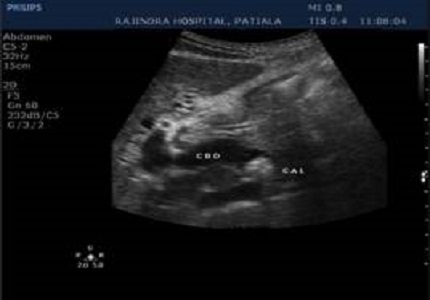Comprehensive evaluation of MRCP versus ultra sonography in biliary obstruction
Abstract
Background: Biliary disorders are one of the common problems routinely seen in clinical practice. Ultrasound (USG) is an initial investigation and Magnetic resonance cholangiopancreatography (MRCP) is a relatively new technique, which has gained popularity because of its excellent diagnostic capabilities in the evaluation of biliary obstruction.
Aims: The aim of our study was to know the cause and grade of obstruction in case of clinically suspected biliary obstruction and to evaluate and correlate the accuracy between MRCP and Ultra sonography.
Material and Methods: This prospective cross sectional comparative study was conducted in the department of Radiology, Government medical college and Rajindra hospital, Patiala. 50 patients with suspected biliary obstruction with clinical and laboratory features suggestive of obstructive jaundice who were referred for USG, followed by MRCP were studied.
Results: Most common disorder observed was choledocholithiasis 16 (32%), followed by carcinoma gall bladder with 7 (14%) cases, periampullary carcinoma with 6 (12%) cases, cholangiocarcinoma and benign stricture with 5 (10%) cases each, carcinoma head of pancreas with 4 (8%) cases, postoperative stricture with 3 (6%) cases and choledochal cyst and cholangitis with 2 (4%) cases each. The overall sensitivity, specificity, positive predictive value and diagnostic accuracy of MRCP in diagnosing biliary obstructive disease was 98%, 100%, 100% and 100%respectively as compared to 60%, 100%, 100%and 97% of USG.
Conclusion: Ultrasound is considered the primary screening investigation modality of choice However, owing to its low sensitivity in most of the benign stenosis and distal common bile duct disease, where the clinical and laboratory suspicion is strong, MRCP is highly accurate, non-invasive, sensitive, non-ionizing and superior diagnostic modality in establishing diagnosis of obstructive biliary pathologies.
Downloads
References
2. Taylor KJW, Rosenfield AT, de Graaff CS. Anatomy and pathology of the biliary tree as demonstrated by ultrasound. Clinics in Diagnostic Ultrasound 1979;1:103-21.
3. Dawson P, Adam A, Benjamin IS. Intravenous cholangiography revisited. Clin Radiol. 1993 Apr;47(4):223-5.
4. Patel JC, Mclnnes GC, Bagely GS, Needham G, Krukowski ZH. The role of Intravenous cholangiographyin preoperative assessment for laproscopic cholecystectomy. Br J Radiology. 1993;66 (792):1125-7. DOI:10.1259/0007-1285-66-792-1125.
5. Reinhold C, Taourel P, Bret PM, Cortas GA, Mehta SN, Barkun AN et al. Choledocholithiasis: Evaluation of MR Cholangiography for diagnosis. Radiology 1998;209 (2):435-42.DOI:10.1148/radiology.209.2.9807570.
6. Wallner BK, Schumacher KA, Weidenmaier W, Friedrich JM. Dilated biliary tract: evaluation with MR cholangiography with a T2-weighted contrast-enhanced fast sequence. Radiology. 1991;181 (3):805-8.DOI:10.1148/radiology.181.3.1947101
7. Magnuson TH, Bender JS, Duncan MD, Ahrendt SA, Harmon JW, Regan F. Utility of Magnetic Resonance Cholangiography in the evaluation of biliary obstruction. J Am Coll Surg. 1999;189 (1):63-72.
8. David V, Reinhold C, Hochman M, Chuttani R, McKee J, Waxman I, Wang L, Li W, Kaplan R, Edelman RR. Pitfalls in the interpretation of MR cholangiopancreatography. AJR Am J Roentgenol. 1998 Apr;170(4):1055-9.
9. Upadhyaya V, Upadhyaya DN, Ansari MA, Shukla VK. Comparative Assessment of Imaging Modalities In Biliary Obstruction. Ind J RadiolImag. 2006;16 (4):577-82.
10. Kushwah APS, Jain S, Agarwal R, Tomar SP. Biliary Tract Obstructive Diseases: A Comparative Evaluation by Ultrasonography and Magnetic Resonance Cholangiopancreatography (Magnetic Resonance Imaging). International Journal of Scientific Study. 2015;3 (4):149-53.
11. Ferrari FS, Fantozzi F, Tasciotti L, Vigni F, Scotto F, Frasci P. US, MRCP, CCT and ERCP: a comparative study in 131patients with suspectedbiliaryobstruction.Med Sci Monit. 2005 Mar;11(3):MT8-18.
12. Siva PA and Sandeep J. Ultrasound and magnetic resonance cholangio-pancreatography correlation in biliary disorders. MRIMS Journal of Health Sciences. 2015;3 (2):142-6. [PubMed]
13. Singh A, Mann HS, Thukral CL, Singh NR. Diagnostic Accuracy of MRCP as Compared to Ultrasound/CT in Patients with Obstructive Jaundice. J Clin Diagn Res. 2014 Mar;8(3):103-7. doi: 10.7860/JCDR/2014/8149.4120. Epub 2014 Mar 15. [PubMed]
14. Kurian JM, Ganesh K, John PK, Hegde P, Murthy C, Kumar A. USG and MRCP Findings in Biliary and Pancreatic Pathologies. International Journal of Contemporary Medical Research. 2017;4 (1):212-5.
15. Schwartz LH, Black J, Fong Y, Jarnagin W, Blumgart L, Gruen D, Winston C, Panicek DM. Gallbladder carcinoma: findings at MR imaging with MR cholangiopancreatography. Journal of computer assisted tomography. 2002;26 (3):405-10.
16. Hurter D, De Vries C, Potgieter PH, Barry R, Botha FJ, Joubert G. Accuracy of MRCP compared with ERCP in the diagnosis of bile duct disorders. SA Journal of Radiology. 2008;12 (1):14-22.doi: https://doi.org/10.4102/sajr.v12i1.580.
17. Bhatt C, Shah PS, Prajapati HJ, Modi J. Comparison of diagnostic accuracy between USG and MRCP in biliary and pancreatic pathology. Ind J RadiolImag. 2005;15:178-81.
18. Shadan A, Malik GM, Kamili MM, Umar K, Showkat H, Willayat A, Suhail M. Role of MRCP in evaluation of suspected biliary and pancreatic diseases. JK-Practitioner. 2011;16 (1-2):20-5.
19. Raguraman P. MRI combined with MRCP versus helical CT in evaluation of patients with obstructive jaundice. International Journal of Recent Scientific Research.2015;6:3642-50.
20. Bhargava SK, Usha T, Bhatt S, Kumari R, Bhargava S. Imaging in obstructive jaundice: A review with our experience. JIMSA. 2013;26:12-4.
21. Al-Obaidi S, Al-Hilli MR, Fadhel AA. The role of ultrasound and magnetic resonance imaging in the diagnosis of obstructive jaundice. Iraqi Postgrad Med J. 2007;6 (1):7-17.
22. Varghese JC, Farrell MA, Courtney G, Osborne H, Murray FE, Lee MJ. A prospective comparison of magnetic resonance cholangiopancreatography with endoscopic retrograde cholangiopancreatography in the evaluation of patients with suspected biliary tract disease. Clinical radiology. 1999;54 (8):513-20.
23. Romagnuolo J, Bardou M, Rahme E, Joseph L, Reinhold C, Barkun AN. Magnetic resonance cholangiopancreatography: A meta-analysis of test performance in suspected biliary disease. Ann Intern Med. 2003;139 (7):547-57.



 OAI - Open Archives Initiative
OAI - Open Archives Initiative


